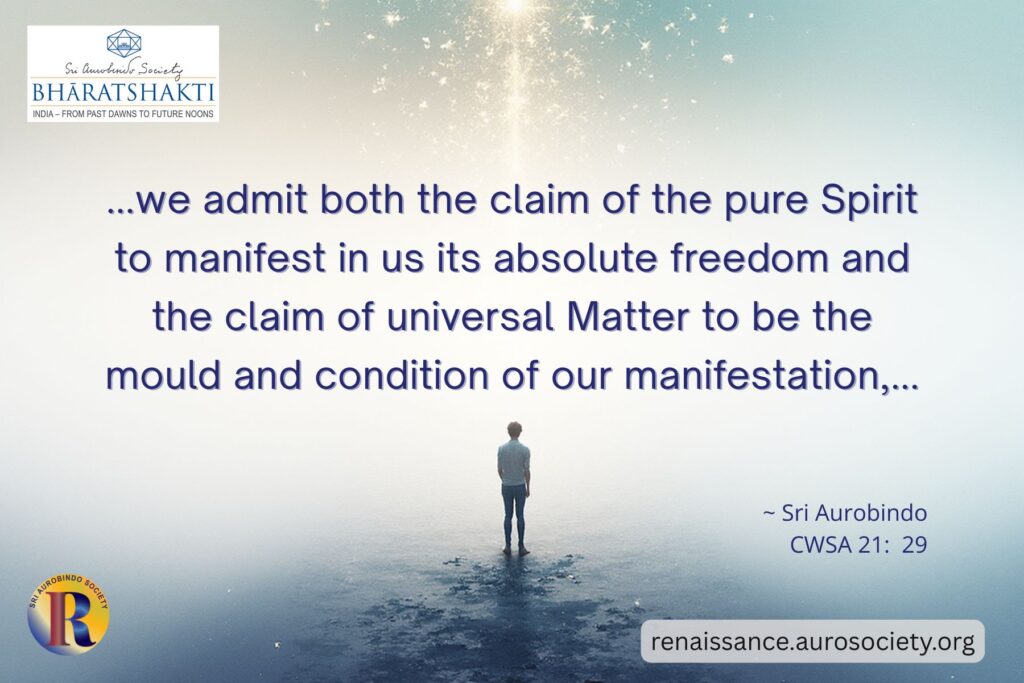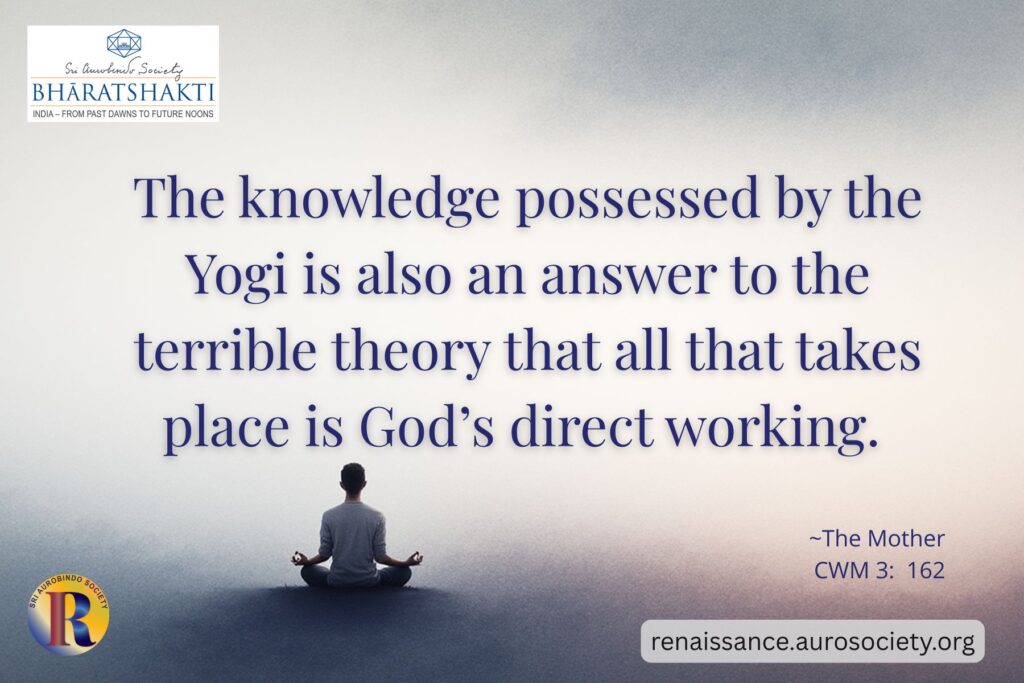Volume V, Issue 1
Author: Beloo Mehra
Editor’s Note: Sri Aurobindo explains that the Gods of the Veda, the powers of Light and Truth, are truly a parable of human life which is “emerging, mounting, lifting itself towards the Godhead.” (CWSA, Vol. 17, p. 78). This 2-part article summarizes Sri Aurobindo’s explanations of the deeper symbolism of these various Vedic Gods and Goddesses.

The Vedic Deities
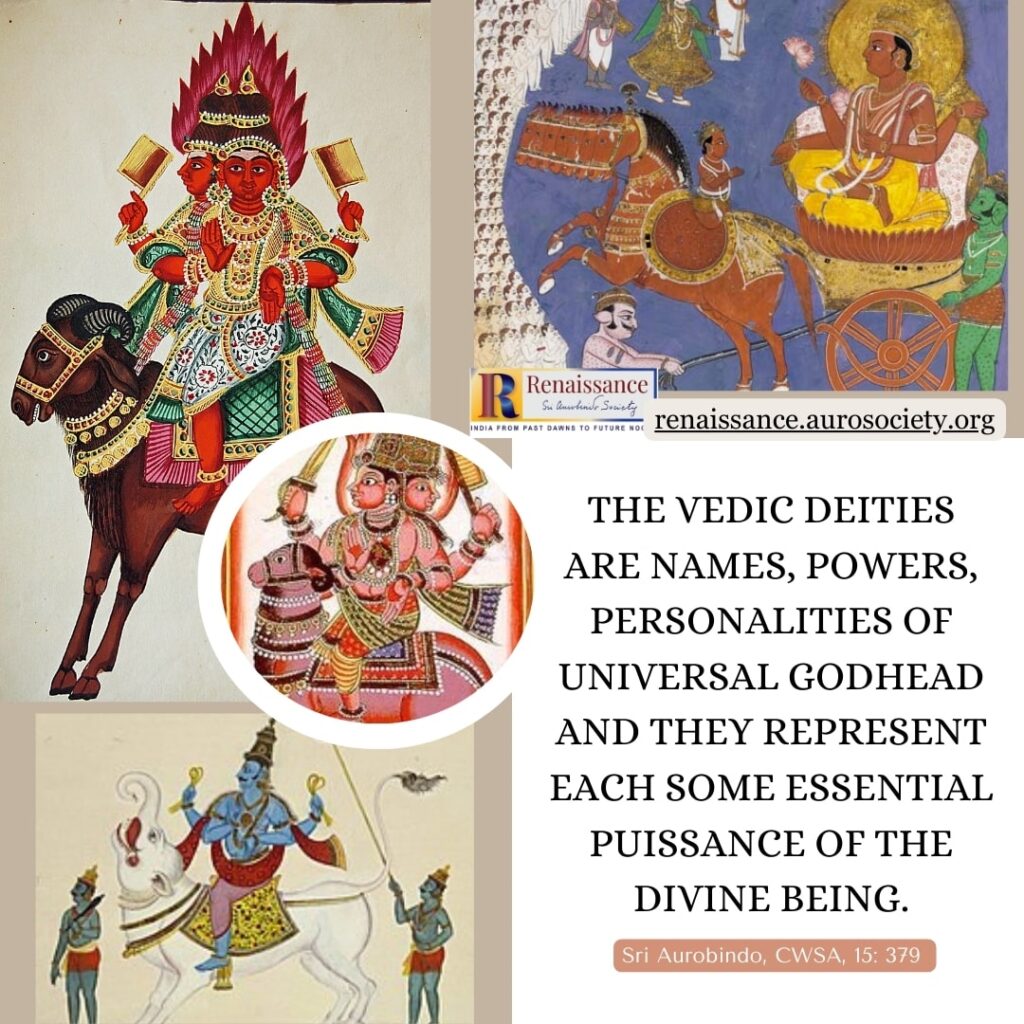
The word deva derived from the root div, which means ‘to shine’, ‘to gleam’ etc. suggests that gods are ‘those who play in Light.’
To the Vedic Rishis, deva-s or Gods are not the givers of material things or the poetical personifications of abstract ideas or of psychological and physical functions of Nature. These Gods are ‘forms and personalities of one Godhead’, ‘living realities’, ‘Children of Light’, ‘Sons of the Infinite’.
The Vedic deities are names, powers, personalities of universal Godhead and they represent each some essential puissance of the Divine Being. They manifest the cosmos and are manifest in it. Children of Light, Sons of the Infinite, they recognise in the soul of man their brother and ally and desire to help and increase him by themselves increasing in him so as to possess his world with their light, strength and beauty.
~ Sri Aurobindo, CWSA, Vol. 15, p. 379
Each hymn in the Veda is dedicated to a particular deity. Invoking these presiding deities, an aspirant prays to attain the specific psycho-spiritual attribute associated with the deity. He seeks to reach the higher planes of consciousness and attain light, strength and beauty.
The “births of the gods” is a common phrase in the Veda by which is meant the manifestation of the divine principles in the cosmos and especially the formation of the godhead in its manifold forms in the human being.
~ Sri Aurobindo, CWSA, Vol. 15, p. 358
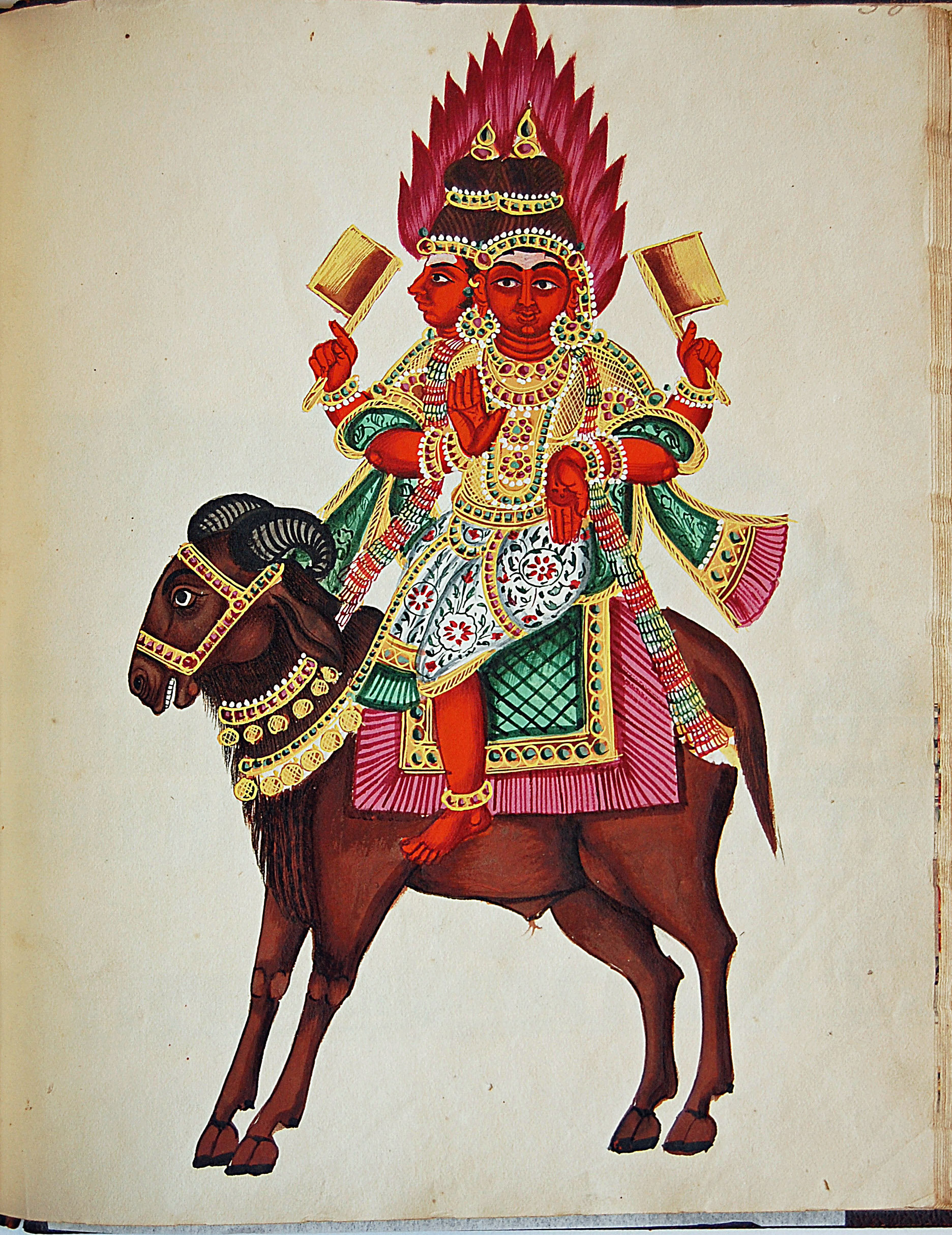
Agni – The First God
The largest number of Vedic hymns are addressed and related to Agni, the mystic fire. This fact is significant and it provides the central key to understanding Vedic system of yoga.
Agni, like many other Vedic terms, has multiple meanings. It means ‘fire’, ‘aspiration’, ‘force of consciousness and urge’, and ‘mounting and burning askesis’. Not merely a principle of physical fire, Agni in the Veda stands much more constantly and thoroughly for the psychological Will-Force. Agni presides over all the psychological activities that relate to will, force, action and energizing. It is the force of evolution that causes growth.
See our Flipbook: Agni in the Veda
The seers invoke Agni at the beginning of the yogic journey, and throughout the journey. Kindling the aspiration is the starting-point of the Vedic practice of yoga.
Agni is thus the aspiration that must constantly burn in the seeker. To that aspiration, the Supreme responds and the response leads to fulfillment and perfection. It leads man in his search for the truth (Satyam). Agni connects man with the cosmic forces and with all the Gods of the three worlds (triloka) – of earth (Bhur), middle world (Bhuvar) and heaven (Swar).
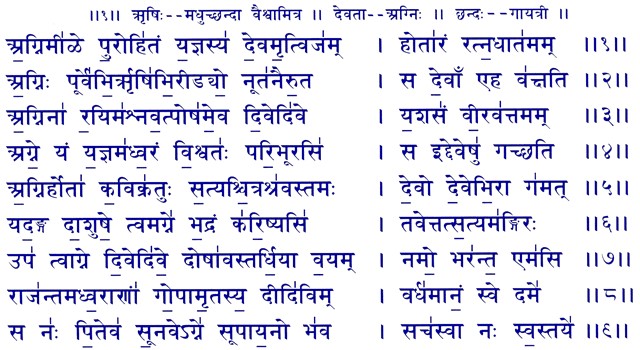
The Root of the Word Agni
Ordinarily, the word ‘agni’ refers to the physical fire; but the Vedic Rishis recognized Agni as the power of aspiration. It initiates man’s journey towards achieving fulfillment and perfection, towards the Truth and the Vast. Burning eternally in the heart of the aspirant, it carries the aspiration to the higher Powers. And brings back in return their force and light and joy into our humanity.
Does the word ‘agni’ have this meaning deep within its structure? See below.
Indra – The Next Step
At the height of the heaven (Swar) is the functioning of Indra. Described as gomat (one who possesses light), he is one who presides over the clarity of the mind (vipaschita). Indra represents a Mind-Power released from the limits and obscurations of the nervous consciousness.
He is not only the illuminer but also the fashioner of forms, the right thought-formations. These are not the forms of the nervous impulses which the falsehoods of senses can easily hamper. An enlightened and illumined Intelligence fashions right or perfect forms of thought and action.
Indra shows man the path that leads him to the higher realms of knowledge and to the Supreme Reality. He is thus connected with Sumati, which is the light in the thoughts, a bright gladness and kindness in the soul, and right sensibilities of consciousness.
The Four Great Powers or Kings
It is not sufficient to only possess the illumined mind. The development of only one faculty is not enough. Through the development of four great powers by the process of a synthesis of the methods of yogic practices one can enter into the realms of knowledge and action that lie between Indra (illumined mind) and the Supreme.
Four godheads preside over these four powers. The Veda describes these four godheads — Varuna, Mitra, Aryaman and Bhaga as kings (Rajanah), and guardians of the light of the Sun.
Varuna and Mitra
Varuna is the cosmic power that enables the seeker of the Supreme to develop wideness and vastness. He also helps the aspirant discover and obey the law of relations of cosmic forces by which harmony can constantly be maintained. Vastness (or universality) and harmony accompany each other. This is why in the Veda, Varuna is always associated with Mitra, who is the lord of harmony.
Varuna is, thus, the psychological name given to the cosmic working of consciousness that is infinite, puissant and pure.

The Divine is boundless Consciousness, perfect in Knowledge, pure and, therefore, luminously right in its discernment of things, perfectly harmonious and happy in its concordance of the law and nature. It is Mitra who brings us this light, harmony, right distinction and relation, and friendly concord.
Mitra is the psychological name given to the cosmic working of consciousness which discerns and distinguishes the complex working of forces. It further harmonizes the truths of all the threads of relationships and weaves them in beauty and perfection.
The union of universality and harmony is a necessary condition for approaching the Divine Truth and its Divine Law. The goal of the Vedic yoga-sādhana (spiritual discipline) is to arrive at the Divine Truth by possessing it in consciousness and knowledge, and to act faultlessly and harmoniously in accordance with the divine law.

Aryaman
Aryaman, the cosmic being who represents the great power of upward endeavour and tapasyā, has also to be fulfilled. The word aryaman is etymologically related to the words arya and ari which mean the heroic traveller, insistent aspirant and a warrior in the battle for the conquest of light.
In the Vedic culture, the word arya signified the traveller on the path and the aspirant to immortality by divine sacrifice, one of the shining children of Light, a worshipper of the Masters of the Truth, a fighter in the battle against the powers of darkness who obstruct the human journey. Aryaman is thus the Force of sacrifice, aspiration, battle, journey towards perfection and light and celestial bliss, by which the path is created, travelled, and pursued beyond all resistance and obstruction to its luminous and happy goal.
The seeker or the yogin who aspires to attain to the workings of Mitra and Varuna is guarded in his progress by Aryaman. The Divine is in its own Being a pure and perfect power, and in us it is the eternal upward tendency of things towards their source and truth. Aryaman brings to us this mighty strength and perfectly-guided happy inner upsurging.

Bhaga
The divine is the pure, the faultless, the all-embracing, the untroubled ecstasy that enjoys its own infinite being and enjoys equally all that it creates within itself. Bhaga gives us that sovereign ecstasy of the liberated soul, its free and un-fallen possession of itself and the world.
An intense aspiration, tapasyā and purity are demanded of the Aryaman in order to arrive at the joy and delight attained by the fulfillment of the nature of Bhaga. All creation originates from delight, and all that flows directly from Bhaga is suvitam, a manifestation of felicity. Bhaga is thus the cosmic power and being conceived as the supreme enjoyer of the Infinite Reality and its Creative Power (Savitra). It opens the gate for the yogin to the Divine Truth and Divine Bliss.
Higher Faculties
Many of the Vedic deities are representation of the higher supramental faculties that an aspirant seeks to develop as part of his yoga-sādhana.
Saraswati
Saraswati is the power of Truth which can be called Inspiration, since it is inspiration from the Truth which purifies by getting rid of all falsehood. She is the impeller of truths and awakener of thoughts in accordance with that which is beneficent. Full of luminous abundance, she is rich in the substance of thought.
By constant awakening and impulsion which results in divine perception (daiva ketu) Saraswati brings into our active consciousness the great flood (maho arnah), the supramental Truth-Consciousness itself. This is how she illumines all our thoughts and upholds the yajña, the sacrifice. For the Vedic Rishis, this Truth-Consciousness is supramental plane, a level beyond our ordinary reach and to which we have to climb with great difficulty.
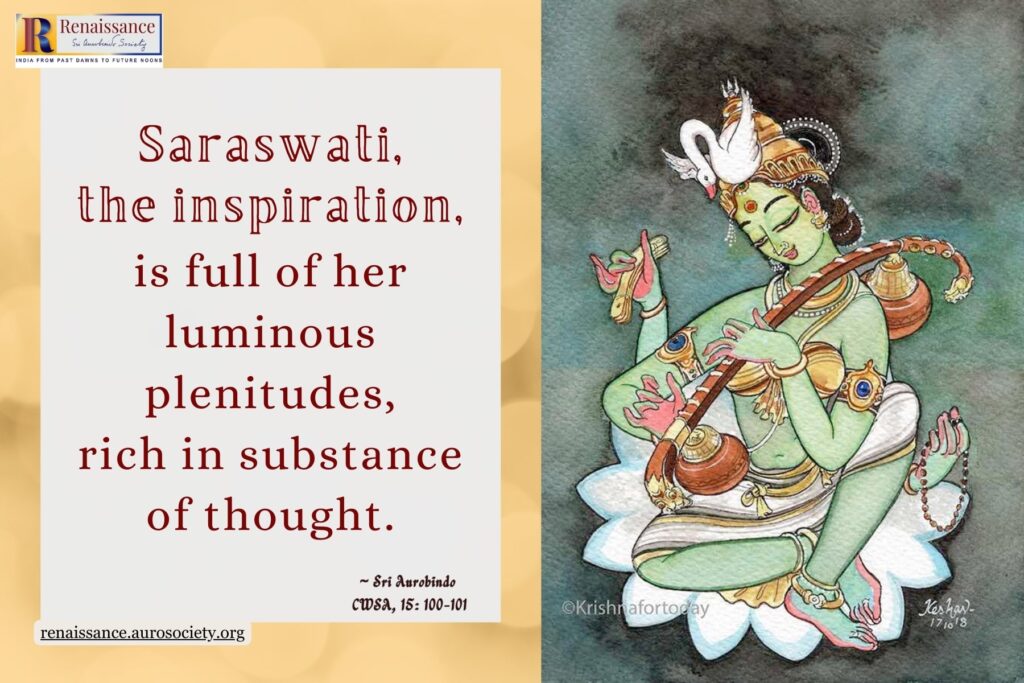
Ila and Mahi/Bharati
Along with Saraswati are hymned two other goddesses, Ila and Mahi (who is also known by the name Bharati). All the three goddesses have connection with light and consciousness.
The light of the Sun represents the Supramental Light which is Bṛhat (brihat, luminous vastness of the Truth). Mahi or Bharati which means ‘largeness’, can be seen to be connected with the bṛhat of the superconscient within us containing in itself the Truth or Ṛtam (ritam). Ila, the power of revelation or Truth-vision is also connected with Surya – the Sun, Lord of True Light, being of one mind with Ila.
In the language of the Veda, Saraswati represents the śruti (shruti) truth-audition or inspiration which expresses itself with the truth-bearing Word. And Ila represents dṛṣṭi (drishti), the truth-vision or revelation. While Bharati or Mahi dawns on man’s limited mind and bestows on it the largeness of the Truth-Consciousness, the two sister powers Ila and Saraswati are also brought forth. These two powers of truth-vision and truth-audition thus characterize the Rishi or the Kavi.
Sarama
Sarama is the leader in the search for the radiant herd of light (read The Legend of Lost Cows). Sarama discovers both the path and the secret hold in the mountain.
She represents a forerunner of the dawn of Truth in the human mind. The faculty which discovers truth in the darkness of the unknown in our being is what we call intuition. Sarama thus symbolizes intuition.
Sarama is distinguishable from Saraswati and Ila. She does not possess the truth as Saraswati and Ila. Even when what is sought is found, Sarama does not take possession but only gives the message to the seers and their divine helpers who have still to fight for the possession of the light that has been discovered.
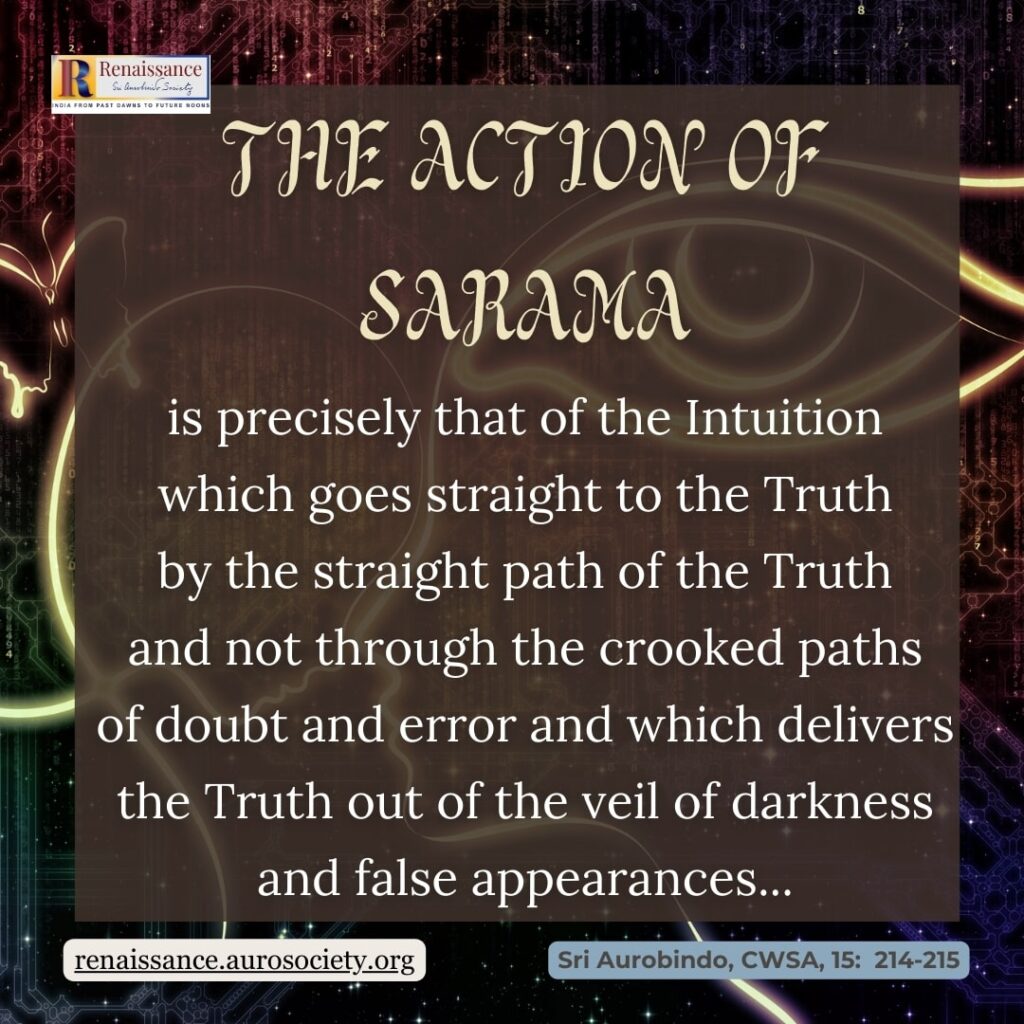
Dakshina
We have in the Rigveda the description of another supramental faculty, namely Dakshina, the power of immediate discrimination or discernment, corresponding to the mental faculty of logical discrimination.
In some passages, the goddess Dakshina seems to be a form or epithet of goddess Usha (Dawn); in some other passages, she is the one who distributes the offerings in the sacrifice. Usha is the divine illumination and Dakshina is the discerning knowledge that comes with the dawn. That discerning knowledge enables Indra, the illumined power in the mind, to know the right and separate the light from the darkness, the truth from the falsehood, the straight from the crooked.
Thus, Dakshina presides as the right-hand power of Indra. She is the goddess in the Vedas who discerns.
Dawn, Sun and Delight
Usha/Uṣás
Usha or Dawn is the goddess symbolic of new openings of divine illumination on man’s physical consciousness. She brings with her a new Sun of Truth.
Sri Aurobindo explains that Usha is truly the divine Dawn. The Sun that arises by her coming is the Sun of the superconscient Truth. “The day he brings is the day of the true life in the true knowledge, the night he dispels is the night of the ignorance which yet conceals the dawn in its bosom.” (CWSA, Vol. 15, p. 244)
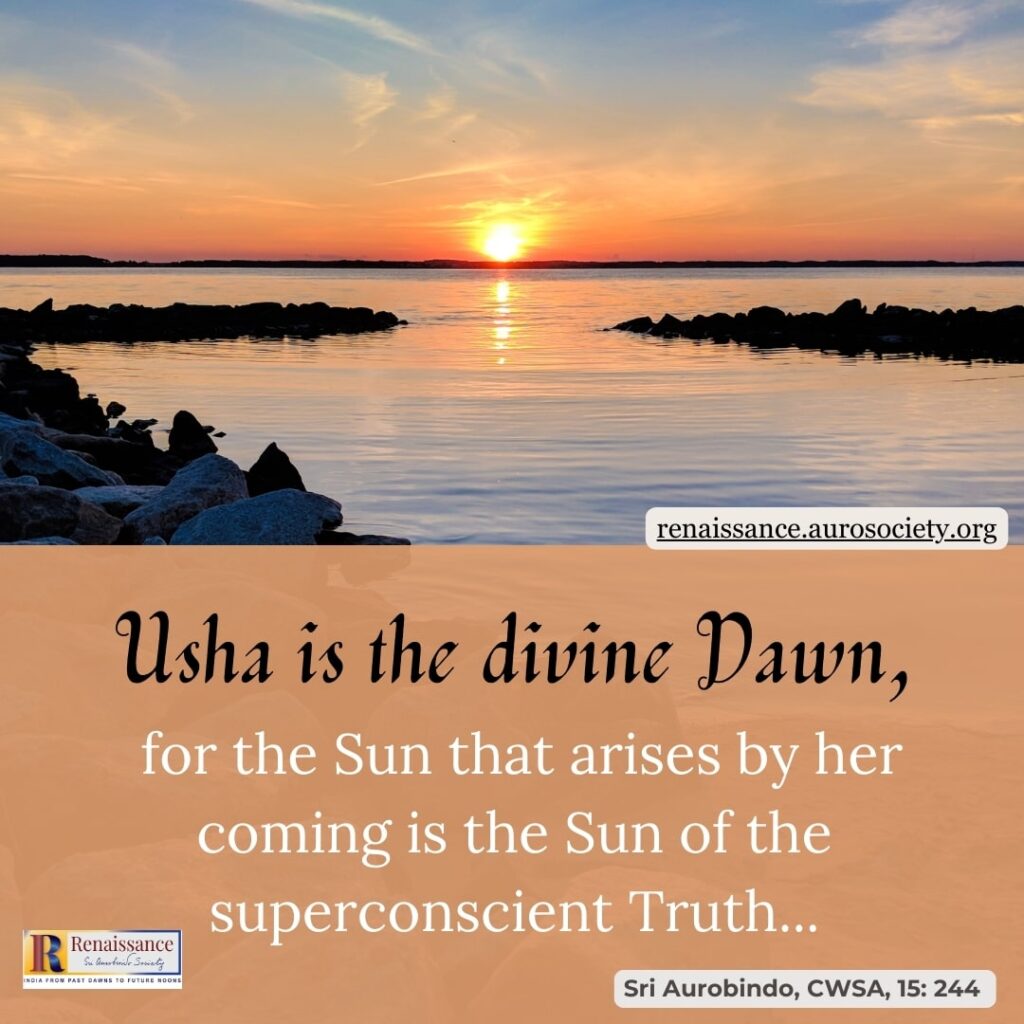
Usha herself is the Truth, sūnṛtā, and the mother of Truths. Her cows, her shining herds, symbolize the truths of the divine Dawn. It is these that are stolen and hidden by the demons, the lords of darkness in their nether cave of the secret subconscient. These illuminations of knowledge have to be delivered out of their imprisonment. Their release by the Angirasa Rishis symbolizes an upsurging of the powers of the Divine Dawn in them.
The truths that Usha brings are accompanied by forces which occupy the Life and bring many enjoyments. These forces are represented by the horses of the Dawn. Much of the Vedic symbolism turns around this symbol of the cows (light) and horses (vital force).
The Dawn is the inner dawn which brings to man all the varied fullnesses of his widest being, force, consciousness, joy; it is radiant with its illuminations, it is accompanied by all possible powers and energies, it gives man the full force of vitality so that he can enjoy the infinite delight of that vaster existence.
~ CWSA, Vol. 15, p. 136
Surya/Sūrya
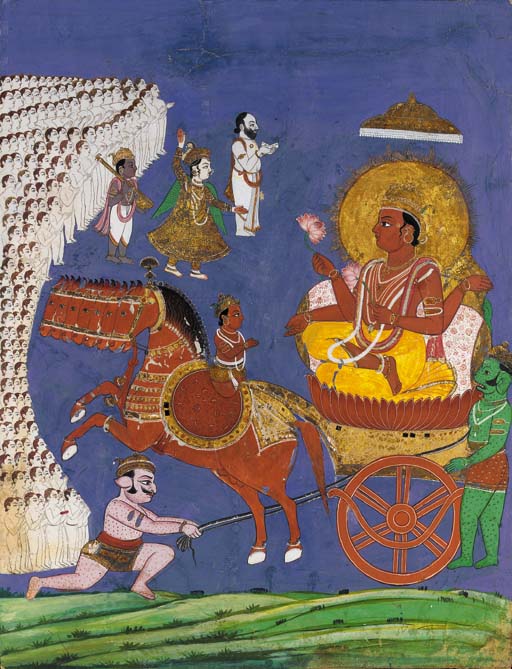
Image: Surya receiving worship, Tanjore style painting, 19th century
source: Wikicommons
The Sun or Surya is described in the Veda as Master of the Truth, as the Illuminator. He is also the Creator (Savitri), and the Increaser (Pūsan).
Surya is the god of revelatory knowledge. He represents the illumination of Truth rising upon the mind. He is the light of the Truth rising on the human consciousness in the wake of the Divine Dawn whom he pursues as a lover follows after his beloved.
Surya means ‘the illumined’ or ‘the luminous’; the illumined thinker is called Suri. Luminous vision as well as luminous creation are the two functions of Surya.
The rays of the Sun are supramental activities of Mahi – widening consciousness, Ila – revelation, Saraswati – inspiration, Sarama – intuition, and Dakshina – luminous discernment. They constitute the action of the Light of perfect Knowledge – Ritam, Satyam and Brihat, the Trinity of Truth, Right and Vast. The rays of this light descend into the human mentality. And they form at its summit the world of luminous intelligence, Swar.
Surya-Savitri
The culminating point of the Vedic Yoga is the attainment of Surya-Savitri, illumination and largeness. Savitri is a seer and the divine creator of all forms for the good of all. He is the Supreme Good. And with the dawning of the light he manifests Heaven wholly and his light pervades all.
By the brilliant light and power of his mightiness Savitri illumines and maps out the realness of earthly light. Savitri is expressed utterly by the rays of the Sun, and reaches the three luminous heavens. The entire world becomes illumined by Savitri.
Soma
Soma is the Lord of the Delight and Immortality. He is simultaneously the offering as well as the god of the sacrifice. He represents the intoxication of the Ananda, the divine delight of Being inflowing upon the mind from the Supramental Consciousness.
The word Soma is derived from the root ‘su’ which means ‘to produce’, ‘press out’, ‘to distil’. It is the supreme production of the Creator, because Ananda is the supreme result of the Truth.
The seers who saw the Truth formed an image of Soma in man. They established him in the race as an unborn child, a seed of the Godhead in man. His is a birth that has to be delivered out of the envelope of the human consciousness.
Continued in PART 2
~ Design: Beloo Mehra

